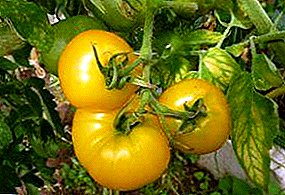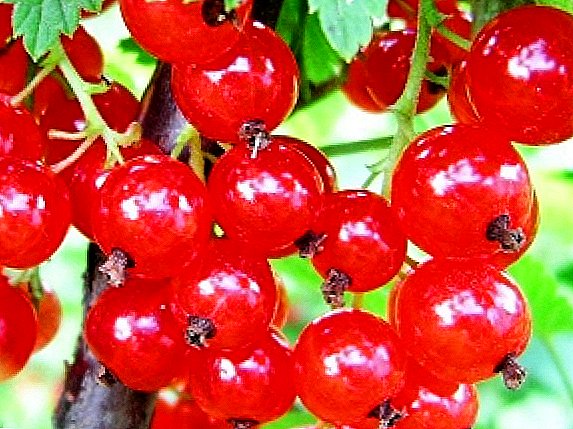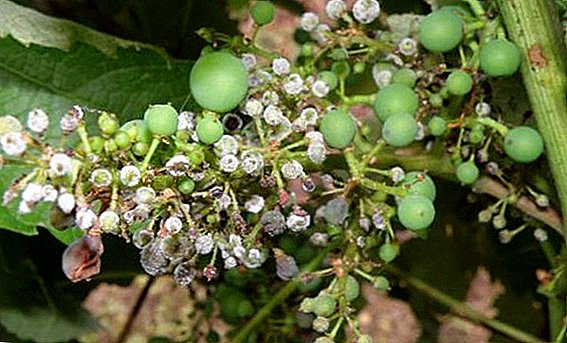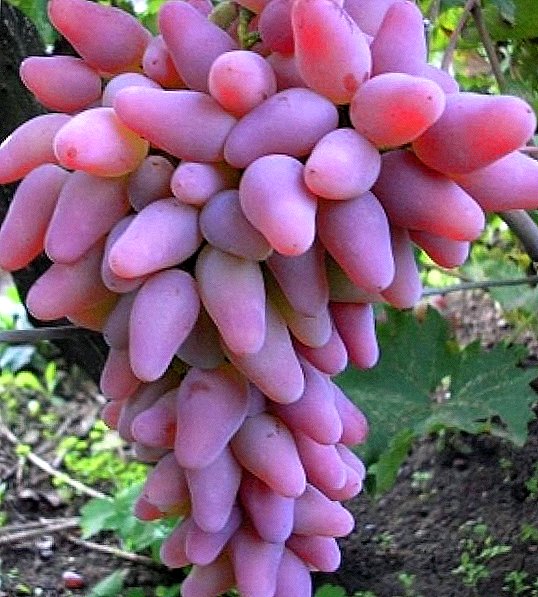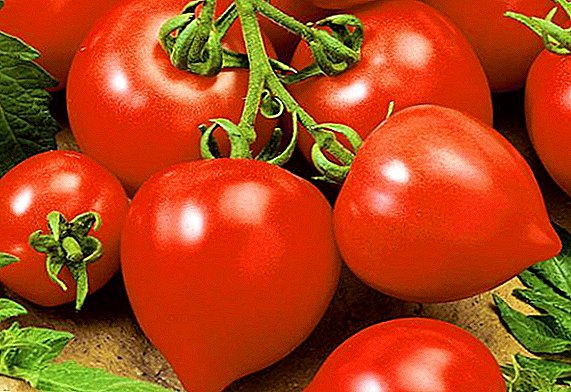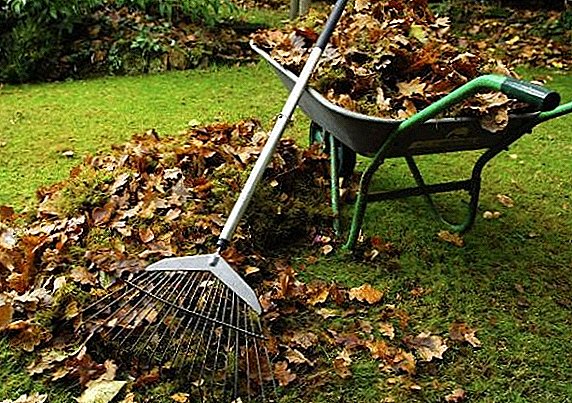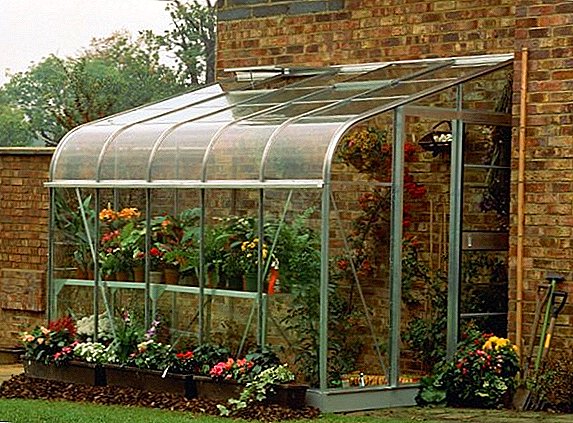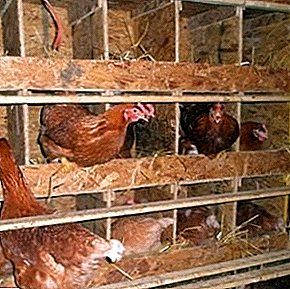
This article will help to understand the process of storing carrots for the winter. How to correctly prepare a vegetable so that it lays until spring, how to cut it and at the same time preserve its taste.
After all, carrots are a capricious plant. To preserve it, you should learn the secrets of this unique and useful root crop before you begin pruning and putting the vegetable in storage.
On the rules of pruning and storage methods, we describe in detail in our article. You can also watch a useful video on this topic.
Peculiarities of vegetable structure
In carrots, the percentage of water is high - up to 80%. Therefore, any negative effect - very humid, damp or dry air at the place of its storage - is unfavorable. Moisture from root crops evaporates and carrots wither.
The microclimate in the storage areas should be constant: without temperature fluctuations and sudden changes in humidity. Carrots will be well preserved and marketable if appropriate conditions are created:
- Observe the optimum storage temperature not exceeding 2 ° C.
- Provide air ventilation. Do not make drafts.
- Humidity should be high, not lower than 90%.
Carrots will be safely preserved if artificial air ventilation is created in the storage facility and the optimum temperature and humidity are constantly maintained.
Choosing the right grade
 Choosing the right grade for long-term storage is an important condition for success.. They must be of high density, free from disease, and without mechanical damage.
Choosing the right grade for long-term storage is an important condition for success.. They must be of high density, free from disease, and without mechanical damage.
It is advisable not to use early root varieties for winter bookmarks. Moisture from them evaporates quickly, it is better to use them fresh. But, if the summer is short and rainy, then later varieties do not fully ripen, do not accumulate sugar and fiber, which means their keeping quality is low.
When buying seeds should pay attention to the following characteristics of the variety:
- the fruit must have the correct form;
- have high yields;
- keep well.
It is recommended for storage to grow or purchase the following varieties of carrots:
- Moscow winter. High-yielding, with an average ripeness of aging, can be stored for up to a year.
- Shantane. Refers to mid-season and high-yielding varieties. Vegetable is juicy, with a sweet taste and a pleasant smell. Shelf life is about 10 months.
- Nantes. Early variety, but subject to the conditions of storage from 8 to 10 months. It has excellent taste.
The following varieties are also characterized by high keeping quality:
- Forto.
- Vita Long
- Queen of autumn.
- Karlen.
- Vitamin 6.
- Samson Cascade.
- Nigel
What is pruning and why is it needed?
Root crop pruning - the procedure for removing the tops of vegetables. It helps to preserve nutrients in carrots, stops rotting, drying out and, as a result, spoils the entire crop.
 The plant left on the root, soon begins to grow actively, take water and useful trace elements from vegetables. Therefore, this process is mandatory.
The plant left on the root, soon begins to grow actively, take water and useful trace elements from vegetables. Therefore, this process is mandatory.
When cutting carrots, it is desirable to consider the shelf life:
- up to 3-4 months - tops are trimmed 2-3 cm above the head of the fetus;
- up to 10-12 months - tops are cut with a vegetable head 2 or 3 centimeters, so vegetables are prepared for long-term storage.
When pruning is deep, with the capture of part of the vegetable, the process of germination of the fruit stops. So, they remain juicy, their taste is preserved. If the carrot is intended for seed, then the green part of the plant is cut, leaving 2 cm.
Do I need to do pruning, if you store vegetables in the cellar?
Whatever the technology of storage - with carrots need to cut the tops. For storage in the cellar, this procedure is required! The knife must be very sharp so that no hemp or cuttings remain on the carrots. In the cellar, such a carrot will not be able to germinate, which means it will retain its taste and beneficial properties.
Detailed instructions on how to do this.
Immediately after harvesting the carrots, on the same day, dry it and you need to start pruning in warm, sunny weather. Cutting carrots correctly is a very important process, which ultimately determines whether the entire crop is preserved. Sometimes it is recommended to remove the tops before harvesting. But in this case it will be inconvenient to pull the vegetables out of the ground.
Do not remove tops by twisting, tearing or breaking.. It can damage the root vegetable.
We will describe in detail the process of carrot proper pruning:
- You need to sharpen a knife or scissors well, so that they are as sharp as possible.
- Since the carrot is a fragile vegetable, it can break if negligent. Therefore, pruning is carried out in two stages: first you need to remove the leaves from the roots.
- Then cut the tops. How to cut it? This should be done by grabbing a few centimeters of the root. How much the slice is below the vegetable head depends on the purpose of storage.
- Chalk is sometimes applied to a fresh cut for reliable results.
- Carefully ensure that there are no growing points or hemp at the cut point.
- Fold the roots in a cool, dry, well-ventilated place. Wait until the surface of the cut on each vegetable will not drag on with a dry crust.
- After that, once again review the harvest and weed out blackened or spoiled roots.
- Take carrots for storage.
Ways to save
There are several proven and guaranteed success methods of high-quality storage of pruned carrots.
Wooden or plastic boxes in the basement
Boxes must be installed no closer than 15–20 cm from the storage wall, due to possible dampness. It is better to install a box with root vegetables on a stand or shelf.
Board: The volume of container should be taken at the rate of 15-20 kg of root crops per container.
Types of fillers in boxes:
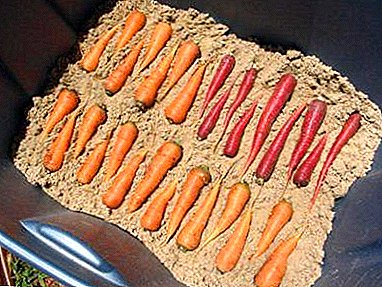 Sand. Sand well preserves the taste of carrots, one of the most popular fillers. Sand should be taken slightly moistened: for this, just a liter of water is enough for a sand bucket. Pour the first sand layer about 5 cm thick at the bottom of the tank, then lay the carrots. It is very important to lay in such a way that there is free space between the roots. Cover carrots with sand, then a layer of sand and so on to the top of the tank.
Sand. Sand well preserves the taste of carrots, one of the most popular fillers. Sand should be taken slightly moistened: for this, just a liter of water is enough for a sand bucket. Pour the first sand layer about 5 cm thick at the bottom of the tank, then lay the carrots. It is very important to lay in such a way that there is free space between the roots. Cover carrots with sand, then a layer of sand and so on to the top of the tank.- Slurry. It is very efficient to store root crops in liquid clay in the basement or cellar. Suitable for those premises where carrots rot and poorly stored. Dilute the clay with water, the mass should drag. Each root crop "bathe" in a clay mash, then dry. Fold in cooked boxes.
- Sawdust. It is better to take sawdust coniferous trees. The phenol contained in this material protects the carrot from infection by rot and other diseases. Root crops are laid in boxes and poured with sawdust in the same way as when using sand, alternating layers.
- Liquid chalk. The method is very similar to the one where liquid clay is used. Each root dipped in cooked liquid chalk (thick consistency). After drying, gently fold the carrot into the container.
- Moss. Carrots do not wash, dry, lie during the day, but not in the sun. The place should be cool and dry. Sphagnum moss (peat) to lay on the bottom of the box. Then, alternating layers like sand or sawdust, fill the entire container with carrots and moss.
Watch the video on how to store carrots:
Polyethylene bags
When storing carrots in bags, you can choose containers of any size, but up to 25-30 kg. It is better to use small packages, designed for 1.5-2 kg, to make it easier to transport and detect damage among root vegetables.
Pre-prepared root vegetables are packed in tight bags, lowered into the basement or placed in a cool and dry storage room. It is necessary to install the packages on the shelves or a special stand.
Packages must not be closed, or many small holes must be made at the bottom.. This is necessary for ventilation so that condensate does not accumulate inside the bag. If, however, the condensate rises, then it is possible to scatter moisture-absorbing substances.
The advantages of this method:
- high air humidity in bags;
- purity of root crops during storage;
- protection from rodents;
- for placing bags suitable for any place in the room or cellar.
But with this method of storage lost part of the taste of carrots.
Watch the video about storing carrots in plastic bags:
In a saucepan or jar
One of the methods of storage is that the prepared roots are placed in enamel pots or aluminum cans. At the same time, root crops in containers are placed vertically.. A lid is placed on top. This method is suitable for cool rooms.
Simple bulk method
 Outdated method. Carrots are poured on the floor in the cellar or basement. With this method, the crop is in danger of being eaten by rodents. In such a pile of roots can dry faster.
Outdated method. Carrots are poured on the floor in the cellar or basement. With this method, the crop is in danger of being eaten by rodents. In such a pile of roots can dry faster.
Depending on what technology is chosen, the shelf life of carrots changes:
- in the clay or chalk "shirt" will last the longest - during the year;
- in containers in which sand, sawdust, onion peel is poured - no more than 8 months;
- poured on the floor or in boxes without fillers - up to six months;
- packed in polyethylene bags, plastic bags - no more than six months.
Possible problems
Carrots during storage can rot, lose taste, reduce weight, lose commercial quality. You need to make sure that this does not happen. To do this, take the necessary measures:
- make sure that the moisture does not evaporate;
- maintain a constant temperature;
- provide good ventilation and air exchange in the room;
- regularly touch and inspect the roots;
- remove damaged fruit, especially those affected by rot;
- in partially spoiled vegetables, remove the rotting area and treat the rest using slaked lime solution or chalk.
Additional tips and warnings
Here are some tips and warnings for storing carrots.:
- It is very important at the stage when harvesting takes place, to reject all damaged roots. High keeping quality is observed only in ripe and healthy specimens.
- In order to prevent cracks in the carrots, which reduce the shelf life, it is not recommended after digging to shake the ground from the vegetables strongly and tap them.
- After cutting the tops of carrots, be sure to wait until the cut dries and tightened with a crust.
- You need to dry not only carrots, but also storage. It should be cool and dry.
- If in the basement there is a threat of freezing of vegetables, then you can wrap containers with carrots with any of the insulating materials.
- Carrots should be isolated from direct sunlight. It is necessary to monitor the moisture in the room so that it is optimal.
- It is necessary to act according to the principle: the smaller the fruit, the sooner it is allowed for processing. Large, large root vegetables are better stored.
- When infecting carrots with rot, do not touch the roots. Very carefully remove the infected fruit and spray this area with lime-fluff to eliminate the source of infection.
Important: The most unsuitable neighbors for carrots are apples. Ethylene released from fruits has a negative effect on the taste of the root.
After reviewing the methods of storage and the process of pruning carrots, each gardener can not only grow a good crop, but also take advantage of the result of his work. Properly preserved vegetable is a source of vitamins and tasty food for the winter table.


 Sand. Sand well preserves the taste of carrots, one of the most popular fillers. Sand should be taken slightly moistened: for this, just a liter of water is enough for a sand bucket. Pour the first sand layer about 5 cm thick at the bottom of the tank, then lay the carrots. It is very important to lay in such a way that there is free space between the roots. Cover carrots with sand, then a layer of sand and so on to the top of the tank.
Sand. Sand well preserves the taste of carrots, one of the most popular fillers. Sand should be taken slightly moistened: for this, just a liter of water is enough for a sand bucket. Pour the first sand layer about 5 cm thick at the bottom of the tank, then lay the carrots. It is very important to lay in such a way that there is free space between the roots. Cover carrots with sand, then a layer of sand and so on to the top of the tank.